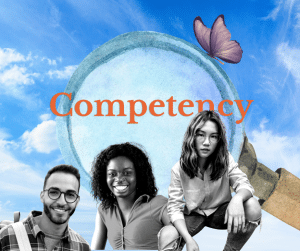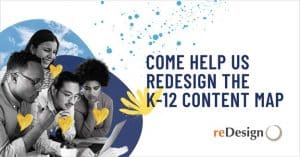Let’s Just Say It Out Loud: There Isn’t Enough Time To Cover All the Standards
CompetencyWorks Blog

Let’s take a trip back in time, before the pandemic. It’s September 29th in an 11th-grade English class in one of America’s biggest cities. For the past 12 days, the students have been working on an in-depth analysis of a Victorian poet’s dramatic monologue about a 16th-century Spanish duke. Ten standards taught, eight assessed in a paragraph-length response. Now it’s time to spend the next two weeks on an Elizabethan-era playwright’s work about a Danish prince, culminating in a multi-paragraph analysis of soliloquy as a tool for character development, to be written over two class periods. Another eleven standards down! Fourteen units to go and, as long as there aren’t any assemblies, district- or state-level tests, or other interruptions, you’ll have an average of twelve-and-a-half days for each of the remaining units, each of which covers a dozen or more standards.
How did we arrive here? Even in the best of circumstances, we often have unrealistic expectations in course, unit, and lesson plans that list dozens of standards to be “covered,” which is at odds with what we know about the importance of depth over breadth. To different levels, many of us are either quietly, subconsciously, subversively, or openly embracing “less is more” when it comes to covering standards. There’s a movement afoot.
Introducing Competencies as a Lens for Prioritizing Standards
When our colleagues at reDesign introduce competencies to teachers, the response is invariably, “Wow! I love these—these are the skills my students need!” Teachers get that competencies, not just standards, capture what is most important for students to learn.
What makes competencies different from standards? Quite a lot, actually. Standards identify the subject-specific what and when for a given content area. They organize the skills, concepts, and knowledge by grade level or grade band. Competencies, on the other hand, organize the transferable skills, strategies, and processes that are important within and across disciplines along a developmental continuum.
For example, the Next Generation Science Standards tells teachers that students in Grade 4 should “Ask questions and predict outcomes about the changes in energy that occur when objects collide.” Compare this with South Carolina’s competency, Investigating through Inquiry, which describes not only the what of asking questions, forming hypotheses, and planning investigations, but also the how of student skills growing over time.
Teachers love the competencies because they can locate their students on this clear developmental path—a continuum—toward an ultimate destination, which, in states like South Carolina and Idaho, is a well-articulated Profile of a Graduate.
Great, right? Not so fast. That initial excitement can easily turn to skepticism, with this common refrain, “I love these, but how am I supposed to teach the competencies and all the standards?”
How indeed. In our work with educators, the shift from standards to competencies brings a sense of relief that comes when leaders openly acknowledge the reality: there just isn’t enough time to cover all of the standards in a way that is meaningful and authentic for students.
When our coaches model the process of bringing competencies and standards together, they use the competencies as a lens to evaluate which standards are most essential for their students. With this clarity, teachers take a more critical approach to the standards, becoming more strategic around the standards they prioritize. They come to rely on the competencies as an essential tool.

Shifting the focus from standards to competencies has had a profound positive impact on the engagement and excitement of teachers we coach. Competencies are reinvigorating because they enable teachers to put students’ needs first and support the design of authentic learning experiences and assessment.
We need a frank discussion about standards and the moment we are in.
As the pandemic in the United States wanes and students return to school, it has never been more clear that an age- and grade-based system of defining what students should know and be able to do is hopelessly out of touch with the reality teachers face. What will it mean to help students “catch up” when the standards-driven curriculum defines what should be taught, leaving little room for giving students what they need?
Our colleague, Sydney Schaef, recently recounted a meeting with education officials and teachers in Idaho, prior to the pandemic. Then Director of the Idaho Mastery Education Network, Kelly Brady, asked “How many state standards does Idaho have for its K-12 education system?” On cue, her staff unrolled a scroll of the state’s 4,758 academic standards, which stretched along the perimeter of the large conference room. Brady asked, “Is this a reasonable expectation, and does it promote relevant learning for all of our learners?”
Imagine this from the point of view of the learner. Across her entire K-12 education, she has just about three hours to learn and demonstrate each of those nearly 5,000 standards. That is two standards each day for thirteen years. In this context, wouldn’t we want a seven-year-old to have more than three hours to “Explain major differences between books that tell stories and books that give information, drawing on a wide reading of a range of text types”?
We need a frank discussion about the shortcomings of the volume of standards and their inability to address the moment we are in.
Practitioners in the world of competency-based education have long been innovating and experimenting with ways to put the focus on the student, not the standards. They have been pushing the boundaries to address the standards in more student-centered ways to meet learners where they are, embodying the definition of competency-based education.
In the world of competency-based education, there are practical solutions that get results. You can find them across the nation in schools and systems that have empowered leaders and teachers to collaborate with students to design and enact learner-centered models. Importantly, these models are accountable to meeting the needs of the living, breathing students in their classrooms, rather than primarily accountable to top-down lists of abstract standards. We’re working with states and systems to create learner-centered competencies designed as a positive, developmental set of transferable skills that support higher-order thinking and depths of knowledge beyond what the standards currently offer.
Wouldn’t it be freeing to have a more flexible place to start?
It has become cliché to say that the pandemic has exposed the insufficiency of schooling as it existed in the pre-pandemic world. The real danger we face is that the greatest opportunity for school redesign in a generation will have passed without changes—real changes—that improve the quality of education for students and the working conditions for teachers.
What if, with boldness and humility and a sense of possibility, we set aside academic standards as we know them, and reimagined the canon of K-12 learning? What if we could center multiculturalism, antiracism, and the best of what we know from the learning sciences, to recast learning outcomes in a truly learner-centered way?
Our team at reDesign is launching an exciting initiative to begin to do just that this summer, convening nearly a hundred content experts from diverse identities, geographies, and life experiences. We look forward to sharing more in an upcoming post. Get a preview here.

Learn More:
- Five Big Ideas for Learner-Centered Competency Framework Design
- What IS the Difference Between Competencies and Standards?
- Building 21’s Open Competencies, Rubrics, and Professional Development Activities
 Jon M. Altbergs is a Designer and Knowledge Builder at reDesign, specializing in the development of curriculum, instruction, and assessment resources that support competency-based learning. Jon has been a classroom teacher, as well as a school-level leader.
Jon M. Altbergs is a Designer and Knowledge Builder at reDesign, specializing in the development of curriculum, instruction, and assessment resources that support competency-based learning. Jon has been a classroom teacher, as well as a school-level leader.
Laurie Gagnon is an Educational Designer at reDesign, where she works with school, district, and state practitioners to design and implement opportunities for students to explore their passions and learn what they need to reach their goals. Prior to becoming a reDesigner, Laurie was the Director of the Quality Performance Assessment Program at the Center for Collaborative Education. She began her professional life teaching English in Japan and teaching high school history in the United States.